It is Festa della Repubblica italiana and Rome, the Capital, is preparing to celebrate it. If you are not a local, you will no doubt have wondered why some of the streets in the historic centre are blocked off and grandstands are set up along Via dei Fori Imperiali in the days immediately preceding 2 June. But let’s go step by step!
2 June: the origins of Italian Republic Day
How did Italian Republic Day first come about? The answer is as simple as significant. Actually, the date coincides with the 1946 referendum, precisely on 2 and 3 June. Italian citizens decided on the Republic as the form of government after 85 years of monarchy, 20 of which were under the fascist regime.
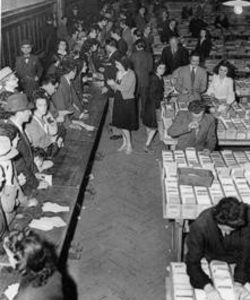
However, there was another somewhat remarkable change in the history of the country’s society and democracy. For the first time, women too finally saw their right to vote recognised. After the universal male suffrage of 1912-13, we reached universal suffrage, which took less time to achieve in other countries.
Italian Republic Day: solemn celebrations
The day of 2 June includes a full calendar of events involving numerous personalities and high state representatives, held in places that are significant symbols of the history and culture of our homeland, of which Rome is the highest expression.
The Frecce Tricolori aerobatic demonstration team
An exhilarating performance is the exhibition of the aerobatic demonstration team known as the Frecce Tricolori (the Italian for “Tricolour Arrows”), which you can also see from some points on the city’s outskirts. These are authentic vaulting performances by the National Aerobatic Team of the Italian Air Force.
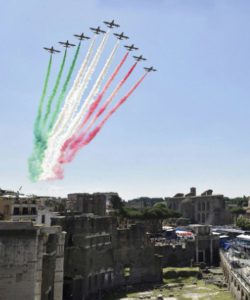
Photo credits: Ministry of Defence official website -https://www.difesa.it/ Frecce Tricolori sui cieli di Roma
With the official name of the 313th Aerobatic Training Group, a total of 10 aircraft – 9 in formation and 1 solo – fly the skies over Rome, which are tinged in red, white and green. Our Frecce hold a unique record: they are the largest aerobatic patrol in the world.
Laying of a laurel wreath at the Vittoriano
According to protocol, the commemoration begins in the morning at one of the most famous monuments in Piazza Venezia. The President of the Republic, accompanied by the highest state officials, usually lays a laurel wreath with a tricolour ribbon – red white and green- at the Tomb of the Unknown Soldier monument.
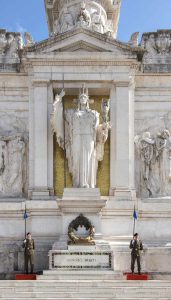
Actually, these are the remains of an Italian soldier who died during the First World War. As his identity could not be traced by any means of identification, he was referred to as “unknown”. Placed under the statue of the goddess Rome at the Altare della Patria at the Vittoriano, it symbolically represents all the fallen and missing soldiers of all wars.
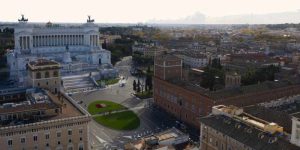
Also known as the National Monument to King Vittorio Emanuele II, the Vittoriano complex stands a stone’s throw from the Capitol. It is considered one of the icons of the Italian nation and the Unification of the country. Its natural location is a continuum between the ancient world – ideally beginning from the adjacent Via dei Fori Imperiali – and the modern city.
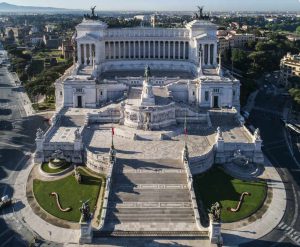
Its characteristic shape, reminding of a “typewriter“, certainly sets it apart from the more classical structures surrounding it. Inside, the Museum houses numerous collections from the Napoleonic era to the First World War (relics, sculptures, weapons, documents, paintings and prints of the Risorgimento) and the Flag Shrine. In addition, it is a permanent venue for remarkable exhibitions and events.
Military parade along Via dei Fori Imperiali
Following the deposition, the Head of State will go to the Palatine Hill, precisely to Via di San Gregorio, where he will meet the units deployed, and then attend the spectacular Military Parade from the Presidential Tribune set up along the picturesque Via dei Fori Imperiali.
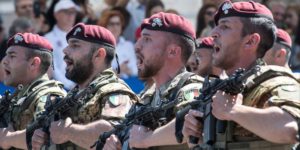
Photo credits: Ministry of Defence official website -https://www.difesa.it/Military Parade: The 1st Tuscania Parachute Carabinieri Regiment
First inaugurated in 1932 by Benito Mussolini under the name Via dell’Impero (the Italian for “Empire Street”), it was later renamed ‘dei Fori Imperiali’ (of the Imperial Forums) due to the wonders we can admire along its 900 m length. The Forum of Caesar, the Forum of Augustus, the Forum of Nerva, the Forum of Trajan, the Forum of Peace, and the Basilica of Maxentius, the Roman Forum, to mention only the main ones.
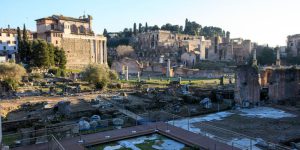
From Piazza Venezia to the Colosseum, this triumphal street celebrates the glories of Rome through every glimpse, every stone, and every ruin. Here, in a location like no other in the world, the parade has been held as an unfailing tradition since 1948. Once, there were also parades of tanks and the Alpini on donkeys. Nowadays, on the other hand, we see the Italian Armed Forces, Police Forces, State Corps, Sanitary Corps, Mayors and Civil Defence walking on this authentic History book.
Firefighters and the Huge Italian Flag at the Colosseum
Flying with emotion and adrenalin is the ascent of the Fire Brigade, which dresses the Colosseum with the national flag. After a daring climb of about 33 metres, firemen from various regional commands and specialised operational units unfold a flag covering 2000 square metres on the facade of the Flavian Amphitheatre, one of the symbols of the Eternal City worldwide.
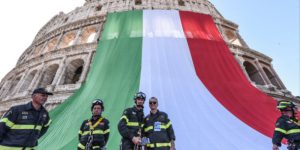
In addition to the parade, this is the special tribute of the Italian Firefighters – beloved by the population- to Italian Republic Day. In such a context, the performance becomes even more impressive.
A “stop” at the Quirinal Hill
According to the schedule, the celebrations move to the Quirinal Hill, President of the Republic seat. In the afternoon, the Gardens of the Quirinal Palace are open to the public. In the time slot from 4.30 p.m. to 6.30 p.m., entrance is reserved for guests with frailties, identified by the national associations of the corresponding categories.
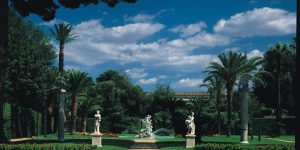
In addition, the programme includes the performance of various band groups, including the Interforce Band, composed of musicians representing the relevant Armed Forces, Police or State Corps.
State museums open for Italian Republic Day
2 June is also an unmissable date to visit the state museums and archaeological parks that remain open free of charge for the occasion. You can consult the list updated in real-time on the official website of the Ministry of Culture, where you will find all the necessary information, from opening hours to the possible need for reservation, required in some specific cases.
Happy Republic Day!
Photo credits: https://www.festadellarepubblica.it/ The Quirinal Palace lighted up with the colours of the Italian flag


